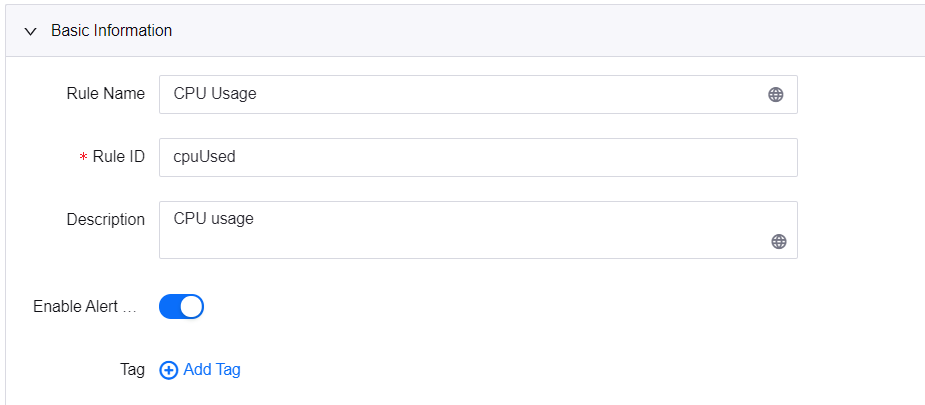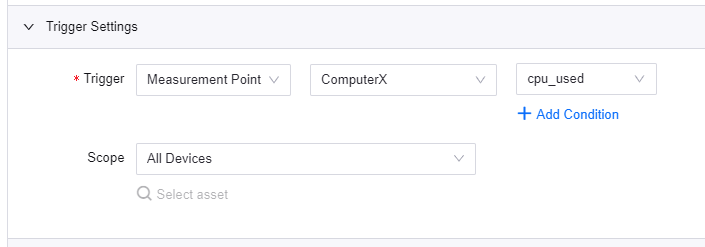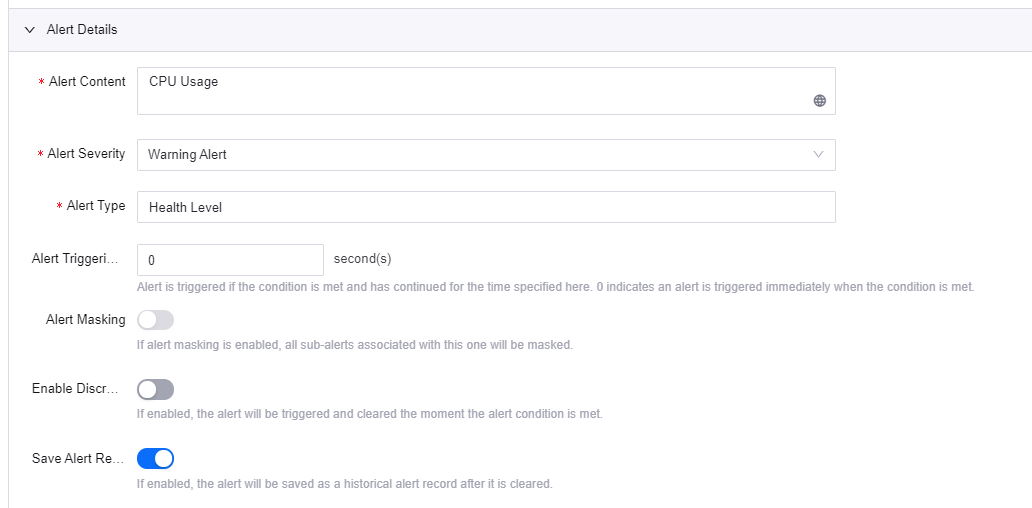Creating Alert Rules¶
You can define alert rules to trigger an alert when certain conditions are met. For example, for wind turbines, you can define a triggering rule to trigger an alert when the wind speed exceeds 30m/s, and the alert severity and alert content will be reported when the alert occurs.
There are two ways you can create alert rules: by using either the old version or the new version. The new version is an enhancement of the old version that gives you more options for comparisons when configuring the condition for the triggering the alert. See the table below for more details.
Old Version |
New Version |
|---|---|
Need to create an alert content before creating an alert rule. |
Alert content and alert rule are merged: alert content can be directly entered when creating an alert rule. |
Can select only one measurement point as trigger condition. |
Can select two measurement points as triggers for comparison as the trigger condition. |
Events cannot be selected as triggers. |
Events can be selected as triggers. |
Can select the device status for all devices under the specified model as trigger condition. |
Can select the device status for all devices as the trigger for the trigger condition. |
Can only use the measurement point threshold as alert trigger conditions. |
Added timing conditions based on tumbling windows as alert trigger conditions. |
Does not support discrete alerts. |
Supports discrete alerts. |
Saves an alert as a historical record by default. |
Supports the option to not save the alert as a historical record after the alert is cleared. |
The alert rules are for the specified model, and can be applied to the following scope depending on the settings:
All the assets instantiated based on the model.
The assets in the specified asset tree which are instantiated based on the model.
This section shows how to create the triggering rules of an alert for the new version. For how to create an alert rule using the old version, see Creating Alert Rules (Old Version).
Before You Start¶
Ensure that the alert severity and type to be used by the triggering rule is created. For more information, see Creating Alert Severities and Creating Alert Types.
Ensure that you have read the limitations for alert rules. See Alert Limitations.
Procedure¶
Click Alert Management > Alert Rules on the EnOS Management Console navigation menu.
Click the New Rule button to define a new alert triggering rule.
Basic Information¶
Fill in the basic information for the alert rule such as its ID, description, etc., in the Basic Information section.

Rule Name
The rule name. Maximum length is 64 characters and supports internationalization.
Rule ID
The user-defined ID for the rule. Supports letters, numbers, period (.), underscore (_), and dash (-), with a maximum length of 64 characters.
Description
The rule description. Maximum length is 100 characters and supports internationalization.
Enable Alert Rule
Select whether to enable this alert rule.
Tag
You can attach custom tags to the rule for easy management. The maximum number of tags you can add is 100.
Trigger Settings¶
The Trigger Settings section enables you to select the triggers required for the trigger condition and the scope of the alert.

Trigger
Select Measurement Point, Event, or Device State as the trigger to trigger the rule.
Measurement Point
Select the asset model and its corresponding measurement point. Click Add Condition to add another measurement point or event as trigger if required. For more information about models, see Device Modeling.
You can have at most 2 triggers per rule. If there is more than 1 trigger, you need to indicate a validity period where the it will be used for the alert condition. You can either select a validity period (between 60 seconds and 24 hours) or use the default Always Effective. If the period is exceeded, the condition will fail, and the alert will not trigger.
Event
Select the asset model and its corresponding event to compare the threshold value of the event’s parameters as the condition. If the condition is not met, the alert will be cleared.
Device State
Select All or Model for a particular model to trigger the alert when the status of the devices under it change to offline. Note that only device assets have device states.
Scope
Select the scope of the asset to which the alert applies to according to the selected model. Scope includes All Devices or an asset tree in the OU.
If All Devices is selected, the rule applies to all asset instances based on the previously selected model.
If a certain asset tree is selected, the rule applies to all asset instances based on the selected model in this asset tree. You can also select one or more nodes in the asset tree to apply the rule to. Newly added child asset nodes will automatically inherit the rule defined on their parent nodes.
The maximum number of nodes that can be selected is 1,000. Note that if you select a parent node that has more than 1,000 child nodes, it counts as 1, but if you do not select the parent node, but instead select 2,000 of its child nodes, the total nodes would count as 2,000 and would exceed the maximum limit allowed.
Condition¶
The Condition section enables you to configure the alert conditions based on the trigger(s) selected.

Condition (for Measurement Point trigger)
Select and configure conditions to trigger the alert.
Threshold: Select this to set a threshold comparison for the trigger selected above.
Select And or Or.
And: Trigger alert only if all the conditions are met.
Or: Trigger alert as long as one of the conditions are met.
Next, select the trigger, operator, and type for the comparison. The options for types are as per the below.
Value: Enter a threshold for the condition.
Attributes: The attributes in the model selected above that have the same data type as the selected measurement point will be listed in the corresponding drop-down. Select the one you require for the triggering condition.
Trigger: Only if two triggers are selected in the Trigger Settings section will this be available. If the two triggers have the same data type, the trigger not selected for the alert condition will be listed in the corresponding drop-down. For example, if two triggers A and B of data type int are selected in Trigger Settings, and trigger A is the alert condition, then trigger B will be shown in the drop-down.
You can add more conditions or condition groups as per required.
Note
There are limitations to the max number of conditions/condition groups that you can add. For more information, see Alert Limitations.
Reporting frequency: Select this to trigger an alert when there is no data reported in the set duration. Only available if a single measurement point is selected as trigger.
No update of data: Select this to trigger an alert when the data reported by the device remains the same with its value unchanged in the set duration. Only available if a single measurement point is selected as trigger.
Condition (for Event trigger)
Configure conditions to trigger the alert.
Threshold: Set a threshold comparison for the trigger selected above.
Select And or Or.
And: Trigger alert only if all the conditions are met.
Or: Trigger alert as long as one of the conditions are met.
Next, select the event trigger, a parameter of the event, operator, and type for the comparison. The options for types are as per the below.
Value: Enter a value for the condition.
You can add more conditions or condition groups as per required.
Note
There are limitations to the max number of conditions/condition groups that you can add. For more information, see Alert Limitations.
Condition (for Device State trigger)
The status of the device to trigger the alert. Currently only supports Offline.
Timing
Enable this function if you wish to trigger alerts according to certain timings. Currently the time window supported is Tumbling Window. Select a duration for each window. If Threshold and Reporting Frequency is selected for Condition, select an operator and value. For more information, see Timed Alerts.
Note
This function is not applicable for Event and Device State triggers and is only available for a single measurement point trigger. If more than one measurement point is selected at Trigger, this function will be disabled.
Alert Details¶
The Alert Details section is where you set more information, such as the alert content, severity, type, etc.

Alert Content
The content of the alert, which may include the possible causes and solutions for the alert. Maximum length is 500 characters. The input supports internationalization, and can be text or a measurement point variable, using its identifier, to return its value.
Format:
"${pointId}"for int, string, float, etc. data types.Format:
"${pointId/parameterId}"for struct data types with parameters.
Alert Severity
Select an alert severity from the list of defined alert severities according to your business needs.
Alert Type
Select an alert type/subtype from the list of alert types.
Alert Triggering Delay
You can set a time in seconds to delay triggering the alert rule. A “0” value will trigger the alert rule immediately when the condition is met.
Alert Masking
Only available when the Scope is an asset tree, or if Timing is not enabled. When Alert Masking is enabled, all the alerts associated with the child nodes of the selected asset node will be blocked. It helps to reduce irrelevant alerts. See Masking Alert.
Enable Discrete Alert
When enabled, the alert will be triggered and cleared the moment the alert condition is met and the alert end time will be the alert trigger time. As the alert is triggered immediately when the alert condition is met, Alert Triggering Delay and Alert Masking will not be applicable if discrete alert is enabled.
Save Alert Record
The option to save an alert as a historical record after it is cleared is enabled by default. Historical records can be searched for and viewed at Alert Management > Alert Records if required. Toggle the switch off if you do not wish to save a historical record of the alert. If not saved, you will not be able to find any record of the triggered alert once it is cleared.
Click Confirm to create the alert rule.
Results¶
After creating or editing an alert rule, the rule will take about 5 mins to take effect. You can view the alert records (if any) at Alert Management > Alert Records.